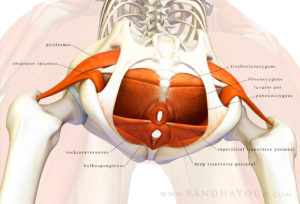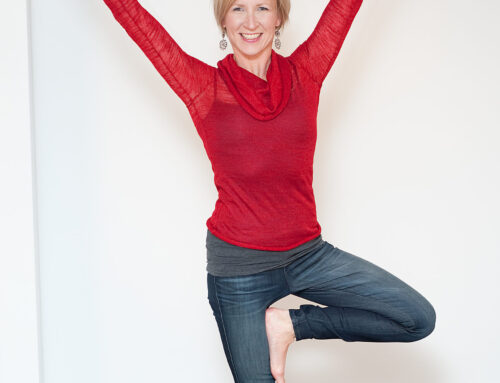
Copyright Ray Long, MD Used with Permission
Integrating Pelvic Floor Cueing into Your Yoga Classes
Shelly Prosko, PT, PYT, C-IAYT
It is wonderful to see the pelvic floor (PF) gain more media attention these days! As a yoga professional, you are well positioned to address PF wellness in your classes for both men and women. Unfortunately, accurate information about the PF is not always conveyed. What is the first thing that comes to mind when you think of practices to promote PF health? Kegel exercises? Mula bandha? If so, you may want to read on.
What are the qualities of a healthy pelvic floor?
While it is true that a healthy PF is one that is capable of being engaged and controlled voluntarily, it also needs to engage automatically in a functional, refined and coordinated way with other muscle groups. A healthy PF also needs to be extensible, be able to relax and move through its full excursion in timing with the respiratory diaphragm during the breath cycle. The PF expands, widens and descends as we inhale; and ascends into its dome-shaped position on exhalation (1). The amount of excursion and force that the PF produces as it moves up and down in timing with breath depends on the demands of the task. The ability of the PF to fulfill its roles in bowel, bladder, reproduction and sexual function as well as the roles it plays in breathing, core strategies, posture, hip function and dynamic balance will depend on a variety of factors. It is beyond the scope of this short blog to discuss those factors, but how we breathe, move, feel, what we think, what we eat, how we respond to and manage stress and how we relate and connect to ourselves, others and the world around us, are all factors that can influence how well the pelvic floor fulfills its roles (1).
Do you over-cue Mula Bandha?
PF health is not just about kegels or mula bandha! In some cases, cueing a PF muscle contraction may interfere with its natural excursion in timing with its synergistic muscles, which is required for adequate core strategies to take place. In other cases, cueing a PF contraction may exacerbate symptoms or certain conditions for a variety of populations (1, 2). That said, there is definitely a time and place to cue an isolated PF muscle engagement; but it is not within a yoga professional’s scope of practice to evaluate the state of the PF in order to know if practicing PF contractions are appropriate for each student; nor can the yoga professional accurately assess if the PF contraction is being performed correctly without actually manually palpating or using electrodiagnostic measuring devices, which are techniques used by licensed healthcare providers such as pelvic floor physiotherapists. Additionally, keep in mind that historically, it appears that engaging and sustaining mula bandha was an energetic practice used to seal, direct and contain the prana in the body during specific pranayama meditation practices along with breath retention, and not necessarily meant to be sustained during movement. Many yogis believe that the current practice of bandhas during movement in modern day yoga classes may have been somewhat ‘lost in translation’ (3, 4).
 Incorporating the PF into your yoga classes:
Incorporating the PF into your yoga classes:
So what can you do as a yoga professional to address PF health and wellness in your classes?
There are lots of options! We can start by cueing the BREATH (2, 5, 6). There are numerous practices that can enhance PF awareness, relaxation, excursion and facilitation of PF engagement that involve cueing the breath. PF awareness practices may include feedback techniques and/or visualization of the rhythm of the PF with the breath cycle in a variety of positions such as extended child’s pose, reclined cobbler’s, happy baby and cat/cow while changing the position of the hips and pelvis to provide different sensations to the PF (1, 5).
PF relaxation may be promoted in certain poses where the hips and pelvis are positioned to allow the PF to gently be in an expanded and relaxed position. This may include extended child’s pose, garland, cow position or happy baby. But keep in mind that the state of the person’s nervous system contributes to muscle tension. So, just because a pose is known to relax and ‘stretch’ a muscle, does not mean it will in everyone. The factors that contribute to whether or not a muscle relaxes are complex! As yoga professionals, you have access to many practices to help your students feel safe and to calm the nervous system which will help relax muscle tension throughout the body, including the PF. You can offer calming breathing practices, mantras, chants, mudras, meditations, supported restorative positions, slow rhythmical movements or use language that can help calm the systems.
There are ways you can facilitate the full excursion and engagement of the pelvic floor muscles in a functional way, without cueing a PF contraction specifically. Research shows that the respiratory diaphragm and PF muscles engage in a sophisticated, automatic, and coordinated way. Focusing on breathing methods that enhance respiratory diaphragm excursion and rib expansion can potentially facilitate PFM engagement. Research also suggests that activation of certain hip musculature plays a role in the functional integration of PF muscle engagement. Therefore, you can use this information to facilitate PFM engagement by choosing poses and movements that are associated with engaging hip muscles such as adductors, gluteus maximus and the deep hip rotators, while at the same time coordinating these movements with the expansive breath, visualization and awareness of the natural PF rhythm.
I wrote about this in more detail in “9 Ways to Help Yoga Students Engage Their Pelvic Floors.”
I hope this provides some new insights and gets you thinking about how you can incorporate PF wellness into your classes in safe and effective ways. For more resources that expand further on this topic, both the theory and practices, see the references below!
References
- Prosko S. Optimizing Pelvic Floor Health Through Yoga Therapy. International Association of Yoga Therapists. Yoga Therapy Today Winter Issue. 2016; 32-34, 48.
- Anderson B. Over-cueing the pelvic floor. Cue the Breath! Pelvic Floor Follow Up – 2015 PMA. YouTube segment. Last accessed September 18, 2018.
- Kaminoff L. Bandhas in a Modern Practice: A Historical Perspective. YouTube segment. Last accessed September 18, 2018.
- Hall C, Garden S. Lost in Translation: Is Mulabandha Relevant for Modern Yogis? Yoga International Online. Last accessed September 18, 2018.
- Prosko S. Creating Pelvic Floor Health Practices with PhysioYoga Videos. Vimeo on Demand. Prosko PhysioYoga Therapy 2016.
- Prosko S. Pelvic Floor Galore! Resources for Creating Pelvic Floor Health Through Yoga. 2016 Last accessed September 18, 2018.
- Prosko S. PhysioYoga and the Pelvic Floor. Pre-recorded Online Course. Embodia Academy 2018.
Thanks for reading!
I’m a physiotherapist and yoga therapist dedicated to bridging the gap between modern healthcare and yoga. I have been integrating yoga practices and philosophy into my physiotherapy practice since 1998. I also teach continuing education courses for healthcare professionals and yoga professionals globally. For more info on my background, schedule and what I am passionate about sharing, please browse this site www.physioyoga.ca
You can find a compilation of all my resources related to pelvic floor and yoga/yoga therapy: Pelvic Floor Galore! Resources for Creating Pelvic Floor Health Through Yoga.
Here are my online PhysioYoga video practices Creating Pelvic Floor Health and my online course PhysioYoga and the Pelvic Floor for professionals interested in learning more about integrating yoga therapeutically into pelvic rehabilitation and wellness care.
In service,
Shelly Prosko
**This workshop is not intended to assess or treat or act as medical advice for your individual health concerns. Please ensure you feel safe to practice in a group class without individual assessment or attention. Please seek guidance and treatment from your health professional in your area for any unmanaged conditions.**





Thanks so much Shelly for this information. Teachers with classes in Youtube and similar platforms often ask for next class suggestions, but never create a class with the PF as a point of focus in my experience!
Thanks so much Shelly for this information. Teachers with classes on Youtube and similar platforms often ask for next class suggestions, but never create a class with the PF as a point of focus in my experience!
Thank you for reading and for commenting, Judy!
I’m happy you found value here.
I hope you also find value in some of the resources at the end of the article. References #5-7 have some great practices (videos: some free on YouTube, some for purchase on Vimeo) and courses that include a nice variety of progressions also.
Cheers,
Shelly